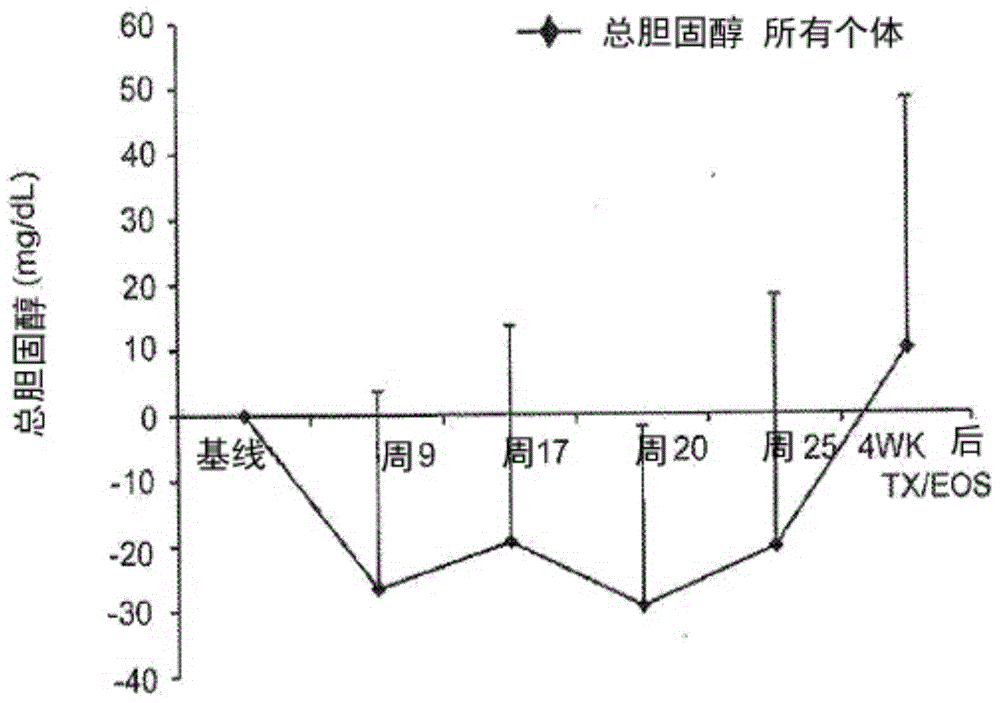Treatment for high cholesterol
A high-cholesterol, cholesterol-high technology, applied in medical preparations containing active ingredients, pharmaceutical formulations, organic chemistry, etc., can solve the problem of not being able to reduce total cholesterol LDL-C and so on
- Summary
- Abstract
- Description
- Claims
- Application Information
AI Technical Summary
Problems solved by technology
Method used
Image
Examples
Embodiment 1
[0234] Example 1: Effect of Compound A on Cholesterol Levels in Treated Anemic CKD or ESRD Patients
[0235] Study 1 was a phase 2 randomized open-label dose-adjusted efficacy and safety study of Compound A in anemic non-dialysis chronic kidney disease (CKD) patients. The primary objective of the study was to evaluate the efficacy and safety of the compound in correcting anemia (ie increasing hemoglobin levels) in non-dialysis CKD patients. The study included 6 dosing groups of approximately 24 individuals each. Subjects in Study 1 received Compound A at a dose range of 1.0 mg / kg-2.5 mg / kg at a frequency of once, twice or three times per week. Groups A and B received a weight-adjusted dose of approximately 1 mg / kg three times a week for 16 weeks; once the anemia was corrected, the dose in group B was reduced to twice a week. Groups C and D received a fixed dose of 50 mg or 100 mg, three times a week, for 24 weeks. Group E received a weight-adjusted dose of approximately 1 m...
Embodiment 2
[0261] Example 2: Reduction of Circulating LDL-C in Healthy Individuals
[0262] Plasma (sodium heparin anticoagulant) samples were collected from subjects receiving placebo (n=6) or 0.75 mg / Kg (n=6) or 1.88 mg / Kg (n=6) compound orally twice weekly. Compound A was taken on the first day after an overnight fast. Subjects were fasted overnight prior to subsequent dosing days. Overnight fasting is not required on non-dosing days. Samples were stored frozen at -70°C for up to 6 years and subjected to up to 2 thaw / freeze cycles before testing. Results are shown separately for samples taken during fasting: Day 1 (0, 1, 2 hours after dosing), Day 2 (24 hours), Day 3 (72 hours), Day 7 (168 hours), Day 10 (240 hours) and Day 17 (408 hours).
[0263] Samples were analyzed using a validation test in a Roche modular system. Total cholesterol was determined using the CHOD-PAP reagent from Roche cat no. 11875540216. HDL cholesterol was determined using reagents from Polymedco Cat# 940...
Embodiment 3
[0267] Embodiment 3: Effect of a single dose of compound A on rat blood lipid panel
[0268] The effect of a single oral dose of Compound A on changes from baseline in cholesterol, HDL, LDL levels and LDL / HDL ratio was evaluated in Sprague-Dawley rats. Compound A was administered at a dose of 60 mg / kg to rats (6 rats / dosing group), followed by overnight fasting. Blood samples were collected at baseline (pre-dose) and approximately 24 hours post-dose to determine levels of cholesterol, HDL, LDL and LDL / HDL ratio.
[0269] The data generated in this study showed that administration of a single oral dose of 60 mg / kg of Compound A to fasted Sprague-Dawley rats resulted in an increase in total cholesterol, LDL and LDL / HDL ratio after a single dose 24 hours significantly decreased from baseline. After 24 hours, total cholesterol decreased by 26±9 mg / dL, HDL decreased by 21±7 mg / dL, LDL decreased by 11±3 mg / dL, and LDL / HDL ratio decreased by 0.14±0.08. The mean percent reduction ±...
PUM
 Login to View More
Login to View More Abstract
Description
Claims
Application Information
 Login to View More
Login to View More - R&D
- Intellectual Property
- Life Sciences
- Materials
- Tech Scout
- Unparalleled Data Quality
- Higher Quality Content
- 60% Fewer Hallucinations
Browse by: Latest US Patents, China's latest patents, Technical Efficacy Thesaurus, Application Domain, Technology Topic, Popular Technical Reports.
© 2025 PatSnap. All rights reserved.Legal|Privacy policy|Modern Slavery Act Transparency Statement|Sitemap|About US| Contact US: help@patsnap.com



